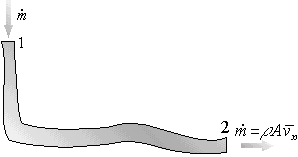Steady incompressible flows through pipes are very important for
many applications. In the simplest case we will have a single
duct with a mass flux ![]() through it:
through it:

Ideally, the flow would be inviscid (no dissipation) and in each cross
section the velocity, pressure and the height would be constant. In
that case the Bernoulli law applies as:
In real flows with dissipation and nonuniform velocity in
the cross sections, we can write
Note: The above equation can be derived by integrating the mechanical
energy equation over the duct. It may then be verified that all
averages are weighted over the mass flux. The exception is ![]() , which
is still the plain average velocity.
, which
is still the plain average velocity.
Note: When treating air at low velocities as incompressible, use a
single density: do not use ![]() and
and ![]() , even if both
densities are known precisely.
, even if both
densities are known precisely.
Note: Conventionally head loss is expressed in units of height, by
dividing the head loss above by ![]() . (In particular,
. (In particular, ![]() becomes
becomes
![]() .) That makes the head loss equal to the height loss of a
manometer measuring the head loss, assuming the manometer is filled
with the same fluid.
.) That makes the head loss equal to the height loss of a
manometer measuring the head loss, assuming the manometer is filled
with the same fluid.